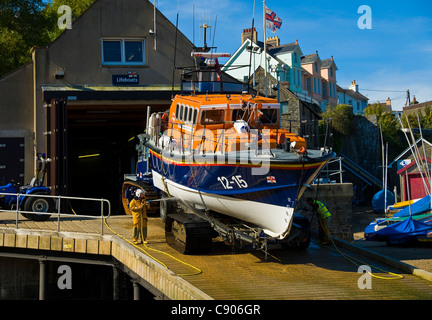


It is necessary to use an inclined slipway to launch lifeboats in locations where there is no natural harbour. Water is selected as the preferred lubrication system due to its ability to reduce sliding friction far below the specification even for shallower 1 in 6 slipways, and also for its cooling effect during the high speeds and high frictional heating in the contact area towards the base of the slipway likely during lifeboat launches. This leads to the recommendation to continue with the adoption of the new composite as a slipway bearing material, and that this material should be run using water lubrication. Results show that the new composite material performs significantly better that the existing slipway lining, meeting the required friction coefficient specification using all lubricants tested. The new composite material is tested using reciprocating tribometers and directly compared with the previously tested composite material. Following this research it was proposed to investigate another similar potential slipway lining material in a similar fashion. However research conducted at Bournemouth University indicates that this may not be the most suitable material available due to a relatively high dry sliding friction coefficient and the ineffectiveness of graphite in reducing friction and wear under lubricated conditions. Currently, a graphite infused jute/phenolic resin composite is the preferred slipway lining material for all lifeboat launch slipways, chosen for its potential ability to run unlubricated or with simple water lubrication, without the manually applied grease previously used on steel lined slipways. lined with low friction composite materials, the lifeboat is released from the top of the slipway and proceeds under its own weight into the water. Lifeboat slipway stations consist of an initial section where the boat is held on rollers followed by an inclined keelway. In locations where there is no natural harbour it is necessary to use an inclined slipway to launch the lifeboat into the sea. This research focuses on the search for suitable alternative slipway linings and lubricants culminating in the recommendation of a new jute/phenolic resin composite lining material to be used with a novel freshwater or seawater lubrication system, and with the development of techniques to reduce panel wear and to establish consistent panel monitoring and replacement criteria with the aim of reducing the environmental, material and economic costs associated with reliable lifeboat slipway operation.ģ40 words) The Royal National Lifeboat Institution provides a marine search and rescue service using a variety of lifeboats and lifeboat stations. Previous slipway launch practice had involved using a greased steel channel, along which the lifeboat keel slides, however with increasing lifeboat mass this has become unsuitable with problems of high friction along the slipway and concerns regarding the environmental impacts of the grease repeatedly being washed into the sea surrounding the base of the slipway. Advances in lifeboat technology has seen the size and mass of slipway lifeboats increase over the years culminating in the new 35+ tonne Tamar class (introduced 2005) and this has presented considerable engineering challenges to the safe and consistent operation of lifeboat slipway stations.

Recovery is performed by manoeuvring the lifeboat keel onto the slipway keelway where a winch line is attached and the lifeboat hauled back into the boathouse at the top of the slipway. The lifeboat is released from the boathouse and proceeds under its own weight along the slipway into the sea. This consists of an inclined slipway, usually at a gradient of 1 in 5-6, with a large boathouse holding the lifeboat under cover at the top. In regions where there is a large tidal range, or where there is no nearby natural harbour it is necessary to use an inclined slipway station to launch lifeboats. This is accomplished using a variety of lifeboats and lifeboat stations depending on local conditions. The Royal National Lifeboat Institution has provided marine search and rescue cover along the UK and Irish coast since 1771.


 0 kommentar(er)
0 kommentar(er)
